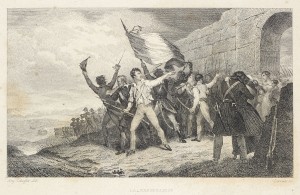The « Illustrated » Marseillaise
In 1825, Ary Scheffer (1795-1858) painted a picture known as “La Marseilleise”–as spelled on the engraving–well before the two famous and largely reproduced artistic representations on this theme were realised : The Departure of the Volunteers of 1792 of the arc de triomphe de l’Étoile sculpted by François Rude between 1833 and 1836 and the painting entitled Rouget de Lisle singing La Marseillaise painted by Isidore Pils in 1849. Although the painting by Ary Scheffer has long since disappeared, it is still known today through an engraving signed by Leroux in 1835 and reproduced here.
An enthusiastic crowd comes through an opening on a visibly old and dilapidated thick stone wall. These are the volunteers of 1792, dressed in the French Romantic fashion. The light-coloured clothes worn by a young man with his arms outstretched and legs apart attract the attention. His head and left arm are turned towards his wife and children also dressed in white. However, his rifle with a bayonet indicates the path taken by a battalion of soldiers marching past in a disciplined rhythm. His right leg stands parallel to those of an old man and a soldier, their hair blowing in the wind. All three keep up with the pace. The soldier from the back waves his hat bearing the French revolutionary roundel and holds a sword. One might even assume that he is boisterously singing La Marseillaise. His posture echoes to the combatant who is holding the flagpole of the Tricolore on which a sharpened pike presages extreme fighting ahead. Brotherhood is enhanced by a young man who, taken by the vibrant motion of the blowing flag, embraces a fellow soldier turning to his own family members while remaining firmly armed with a sabre. At the forefront a couple kisses in the shadows, the soldier’s rifle against the wall.
This representation of La Marseillaise corresponds to the historical narrative given by Jules Michelet (1798-1874) in his History of the French Revolution published between 1847 and 1853 : “Contrary to popular belief, it was not during a family dinner that the sacred song was created. It was amid an emotional crowd”. A coloured engraving inspired by the painting by Scheffer and called Arise ! is currently kept in the Carnavalet Museum. This engraving was realised by the Gihaut brothers in 1830. Blue and red colours are used as main dominant colours in an artistic composition that is the mirror image of our engraving.
The engraving reproduced here is contemporary to the July Revolution of 1830 or the socalled “Three Glorious Days of July 27, 28 and 29, 1830”, during which King Louis Philippe took over power and installed the so-called “July Monarchy”. It is also in 1830 that Eugène Delacroix painted his famous painting known as Liberty Leading the People. The allegorical goddess-figure of Liberty holding the flag of the French Revolution over the barricades was most certainly an inspiration for Rude’s sculpture Genius of War on the arc de triomphe de l’Étoile. It is also in July 1830 that Hector Berlioz arranged a new orchestration of La Marseillaise that he dedicated to Rouget de Lisle who was then residing in Choisy-le-Roi. In a letter written by Rouget de Lisle to Berlioz on 20 December 1930, he suggested to meet in order to work together. On 29 December, Hector Berlioz replied : “Monsieur, I just received your letter at this very moment but I shall be leaving within a few hours. I must go to Italy not to lose my Prix de Rome scholarship at the Institute. Therefore, I shall be deprived of the honour of seeing you. I am distressed at this unfortunate circumstance ; one of my passionate dreams has always been to personally meet with the composer of La Marseillaise, and the opportunity that he, himself wishes to offer me would have been accepted with the outmost diligence, if it were not for this fatal journey”. Ultimately, this meeting did not take place.
Listen to the full version harmonized by Berlioz (10:50)
Listen to a sample



Ajouter un commentaire